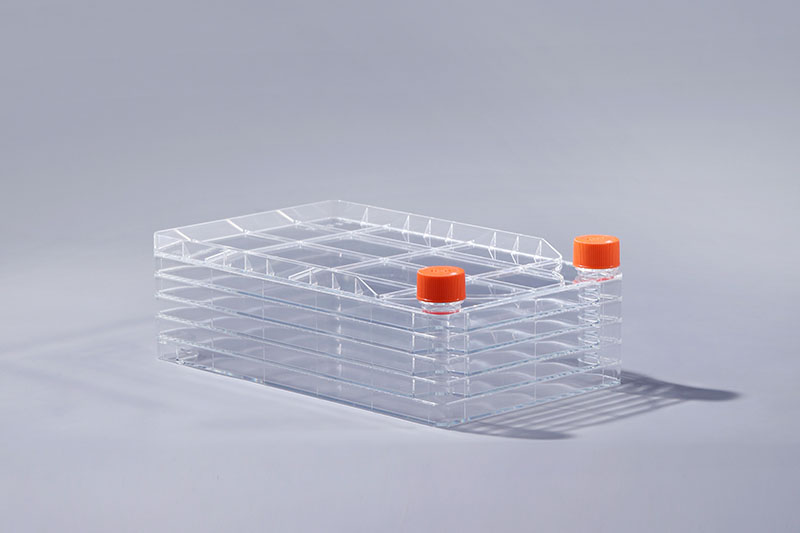С бурным развитием биофармацевтической промышленности использование технологии клеточных культур для проведения исследований вакцин, моноклональных антител и других лекарств стало тенденцией. Кроме того, клеточная фабрика также может использоваться для крупномасштабного производства вакцины MMR, вакцины против гепатита А, вакцины против полиомиелита и т. д. С быстрым развитием биомедицинских технологий область применения этого расходного материала также будет становиться все шире и шире. являются широко используемыми расходными материалами в крупномасштабном культивировании клеток, которые играют важную роль в крупномасштабном производстве вакцин против ветряной оспы. вирус зостер. Клиническими симптомами являются лихорадка, в основном пятна, папулы, везикулы и струпья группами, а в тяжелых случаях даже смерть. Вакцина против ветряной оспы является самым безопасным и наиболее эффективным способом профилактики ветряной оспы. В вакцине против ветряной оспы используется аттенуированный штамм вируса ветряной оспы OKa, который широко используется в мире, и производится из культуры диплоидных клеток человека MRC-5. Внешний вид лиофилизированного продукта представляет собой рыхлое тело молочно-белого цвета, а после растворения представляет собой бледно-желтую жидкость. Получение вакцины против ветряной оспы не только защищает от ветряной оспы, но и предотвращает осложнения от ветряной оспы. увеличиться, и он имеет большой объем рынка. Различные практические опыты также доказали, что, по сравнению с другими расходными материалами для культивирования, использование клеточных фабрик для крупномасштабного производства вакцины против ветряной оспы имеет преимущества меньшего загрязнения, высокого выхода продукта, небольшой вариабельности от партии к партии и короткого времени работы. . Важный метод культивирования клеток для предприятий.
Chickenpox is a highly contagious acute infectious disease caused by the varicella-zoster virus. The clinical symptoms are fever, mainly macules, papules, vesicles and scabs in batches, and even death in severe cases. The chickenpox vaccine is the safest and most effective way to prevent chickenpox. The varicella vaccine adopts the attenuated strain of varicella virus OKa, which is commonly used in the world, and is made by MRC-5 human diploid cell culture. The appearance of the freeze-dried product is a milky white loose body, and it is a pale yellow liquid after dissolving. Getting the chickenpox vaccine not only protects against chickenpox, but also prevents complications from chickenpox shingles.
Since August 1, 2018, the varicella vaccine has been included in the Shanghai Municipal Immunization Plan, and people's attention to the varicella vaccine has continued to increase, and it has a large market volume. Various practical experiences have also proved that, compared with other culture consumables, the use of cell factories for large-scale production of varicella vaccine has the advantages of less pollution, high product yield, small batch-to-batch variability, and short operation time. An important cell culture method for enterprises.
In addition, the cell factory can also be used for large-scale production of MMR vaccine, hepatitis A vaccine, polio vaccine, etc. With the rapid development of biomedical technology, the application scope of this consumable will also become wider and wider.
The FAI climbed 5.9 percent year-on-year in the first 11 months of 2018, quickening from the 5.7-percent growth in Jan-Oct, the National Bureau of Statistics (NBS) said Friday in an online statement.
The key indicator of investment, dubbed a major growth driver, hit the bottom in August and has since started to rebound steadily.
In the face of emerging economic challenges home and abroad, China has stepped up efforts to stabilize investment, in particular rolling out measures to motivate private investors and channel funds into infrastructure.
Friday's data showed private investment, accounting for more than 60 percent of the total FAI, expanded by a brisk 8.7 percent.
NBS spokesperson Mao Shengyong said funds into weak economic links registered rapid increases as investment in environmental protection and agriculture jumped 42 percent and 12.5 percent respectively, much faster than the average.
In breakdown, investment in high-tech and equipment manufacturing remained vigorous with 16.1-percent and 11.6-percent increases respectively in the first 11 months. Infrastructure investment gained 3.7 percent, staying flat. Investment in property development rose 9.7 percent, also unchanged.
 English
English



















































